#Activity4
Explore tagged Tumblr posts
Text
360 Pest Solutions Blogs
Pest control is a critical aspect of maintaining a healthy and safe environment, whether in residential or commercial settings. The term "360 Pest Solutions" encompasses a holistic approach to pest management that integrates various strategies and technologies to effectively prevent and manage pest infestations. This blog explores the concept of 360 Pest Solutions, its components, and its benefits, while also highlighting some key players in the industry.
What is 360 Pest Solutions?
360 Pest Solutions refers to a comprehensive pest management strategy that addresses pest issues from multiple angles. This approach includes:
Preventive Measures: Implementing strategies to deter pests before they become a problem.
Integrated Pest Management (IPM): Utilizing environmentally sensitive methods to control pests while minimizing chemical use.
Regular Monitoring and Maintenance: Conducting routine inspections and treatments to ensure ongoing protection against pests.
Education and Awareness: Informing clients about pest behavior, prevention techniques, and the importance of early intervention.
This all-encompassing strategy is designed to create a sustainable pest management system that not only addresses current infestations but also prevents future occurrences.
Key Components of 360 Pest Solutions
Assessment and Inspection
A thorough inspection of the property is essential to identify potential entry points and existing infestations. This includes checking for signs of pests in hidden areas such as attics, basements, and crawl spaces.
Customized Treatment Plans
Based on the inspection findings, pest control professionals develop tailored treatment plans that may include chemical treatments, traps, or natural deterrents. For instance, companies like 360PestControl utilize advanced technologies such as radar and thermal imaging to detect hidden pests without invasive procedures3.
Preventive Strategies
Preventive measures are crucial in maintaining a pest-free environment. This may involve sealing cracks and crevices, installing screens on windows and doors, and managing landscaping to reduce pest habitats.
Ongoing Maintenance
Regular maintenance schedules help ensure that any new pest threats are addressed promptly. Many companies offer tri-annual or monthly service plans that include inspections and treatments tailored to seasonal pest activity4.
Education for Clients
Educating clients about pest behavior and prevention techniques empowers them to take proactive steps in their homes or businesses. Understanding the lifecycle of common pests can help in identifying potential problems early.
Benefits of 360 Pest Solutions
Implementing a 360 Pest Solutions strategy offers numerous advantages:
Comprehensive Protection: By addressing all aspects of pest control, this approach minimizes the risk of infestations.
Cost-Effectiveness: Preventive measures can save homeowners money by reducing the likelihood of severe infestations that require extensive treatments.
Environmental Responsibility: Utilizing IPM practices reduces reliance on harmful chemicals, promoting a healthier environment for families and pets2.
Long-Term Results: Regular monitoring and maintenance lead to sustained pest control success.
Industry Examples
Several companies exemplify the principles of 360 Pest Solutions through their services:
Good Monsters Pest Control offers a Home360 plan that creates protective barriers around properties while providing regular maintenance services for over 35 common pests1.
Safari Tree has introduced a Tri-Annual 360° Pest Control Program that focuses on creating barriers around homes to eliminate or prevent various pests through seasonal treatments4.
Brock 360 Pest Solutions emphasizes the importance of proactive measures and provides expert insights into effective pest management strategies through their blog6.
The adoption of 360 Pest Solutions represents a significant shift in how pest management is approached. By integrating various strategies and focusing on prevention, this comprehensive method not only addresses current infestations but also safeguards against future threats. Homeowners and businesses alike can benefit from this holistic approach by ensuring their environments remain safe, healthy, and free from pests.
For those seeking effective pest control solutions, considering companies that implement 360 Pest Solutions can lead to better outcomes. Whether through advanced technology or environmentally friendly practices, these solutions provide peace of mind knowing that comprehensive care is taken to protect homes and businesses from unwanted pests.
#bird control gold coast#bird control#certified pest control#pest control#bird control brisbane#commercial pest control brisbane
0 notes
Text



1. What personal information or details did the writer reveal about herself? She reveal about the relationship with her parents over the years when she grew up how her parent didn’t show her the love as a daughter like other Pilipino parents would do and how she was alone and her father doesn’t care about her and how her mother change her face and make her feel that she is an eye sore. 2. What personal information or details did the writer reveal about her parents? Her parents is selfish, toxic, careless and even her own parents bullied her. 3. How do you find the characterization of a story? By observing how her parents treat her and How she behave as a child throughout the years of her being lonely and have no friends. 4. How did the writer portray herself and her family in the essay? She portray herself by writing her own story, experiences, how her parents treat her when she was little. 5. What is the author’s view about being beauty queen? She wants to become a beauty queen for her mother and she can prove to her that a girl can be beautiful even without changing her face. True beauty defines within. 6. What is the central idea of the essay? The central idea of essay for me is we should raise a child with love and care because his or her past can change the way you treat them, there is no size, color of skin and your unique features we can be absolutely beautiful in our own way.
0 notes
Text
Habitica App Review
Click HERE to view larger document!


1 note
·
View note
Photo

Not a very original concept
0 notes
Text
Blog multidisciplinario
ccss-Geografia de Nicaragua
1-Reflexion :La familia es un espacio seguro y sociable,de amor y confianza.Donde nos apresian ,aceptan y respetan nuestra personalidad y desiciones.
2-MAPAMENTAL
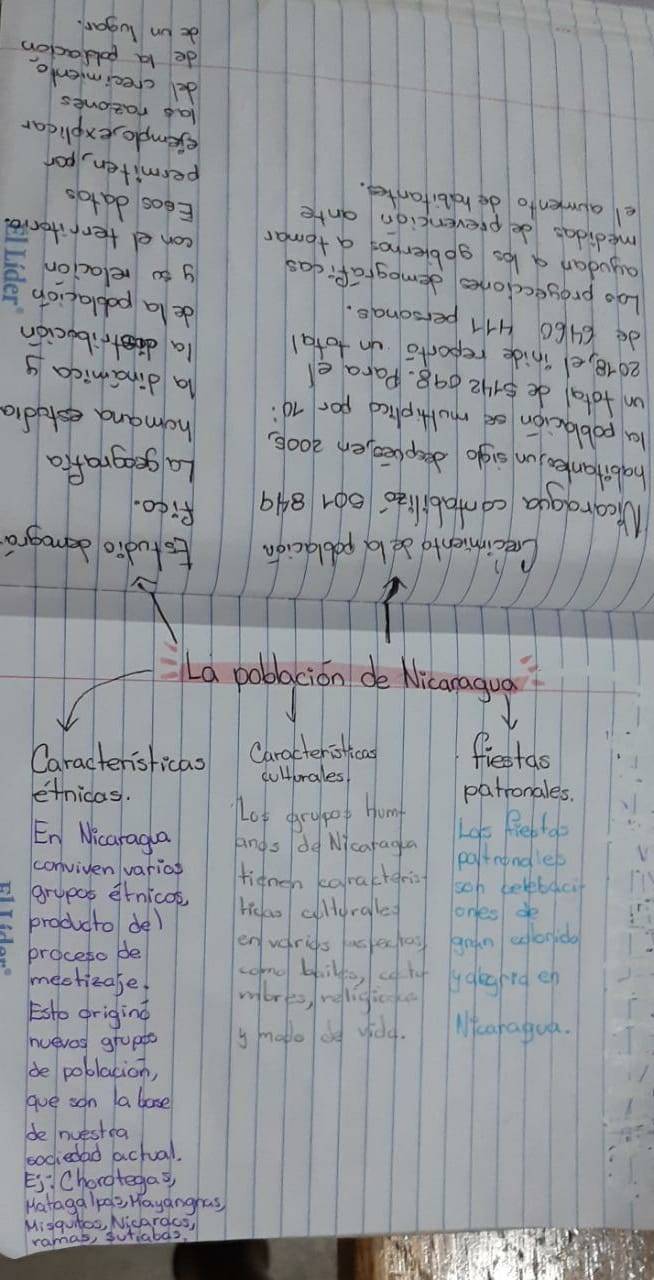
3-Escribe ua reflexion sobre los siguientes conceptos:Grupos etnicos ,taza de crecimiento,fecundidad,taza de fertilidad,natalidad,mortalidad y crecimiento poblacional.
Los grupos etnicos: Son grupos de individuos que comparten una identidad determinada .
Taza de crecimiento:Es el incremento o aumeto de la poblacion.
Taza de fecundidad: Es el numero de nacimientos ocurrido en un cierto periodo de tiempo
Natalidad:Es el numero de nacimientos vivos de una poblacion .
Mortalidad:Es la proporcion de personas fallecen de la poblacion en un periodo de tiempo.
Crecimiento poblacional: Es el cambio de numeros de individuos en una poblacion.
4-¿Que son los derechos humanos?
Son derechos que tiene cada persona sn distincion de raza o nacionalidad. Todo ser humano tiene derecho como un nombre,a la esducacion , a salud , a una nacionalidad,etc.
¿Cree que es importante saber sobre los derechos humanos?
Si ,porque como persona no permitira que te denigren o menos precie como persona y puedas exigir tus cderechos en cualquier situacion.Derecho que no se defiende es derecho que se pierde.
English
Activity 1.write 5 countries and their capital.
COUNTRY - CAPITAL
1-Nicaragua -Managua
2-Panama - Panama
3-Salvador - San Salvador
4-Costarica - San Jose
5-Argentina -Buenos Aires
Activity 2 . Draw 3. Translate in to spanish
1.coast-costa 5.Dune-duna 9.glacier-glaciar
2.sea-mar 6. cliff-acantilado 10.forest-bosque
3.river-rio 7. mountain-montaña 11.meadow-prado
4.desert-desierto 8.jungle-selva 12.island-isla
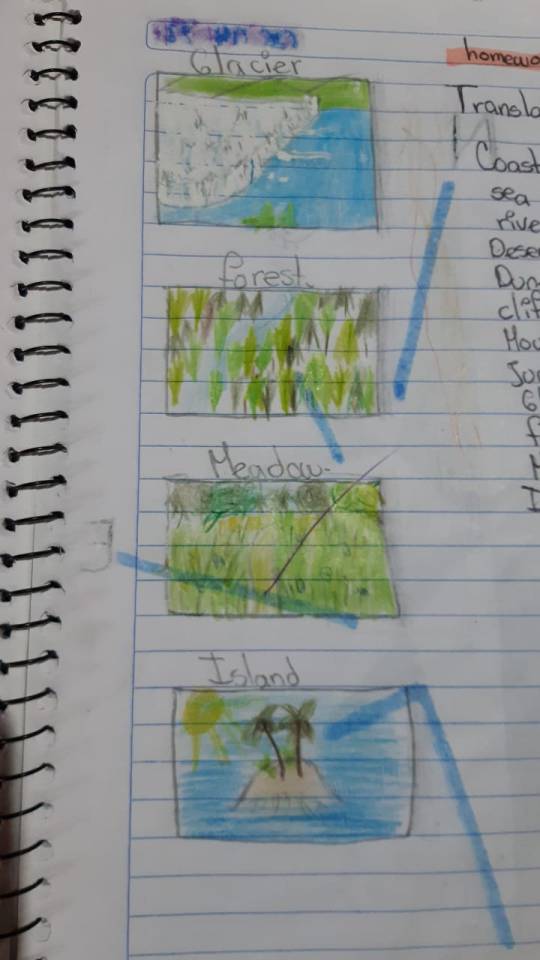

Activity4 . look at the compass.complete
1.NORTH 5.EAST
2.SOUTWEST 6.SOUTH
3.SOUTHEAST 7.WEST
4.NORTHEAST 8.NORTHWEST

Activity 5.Answer the questions.
1.Which direcion point to the top of the page?North
2.Which points of the compass rose are the longest?West,East
3.What direction is between south and west?Soutwest
4.How many directions are shown in the compass rose?Eight
5.What direction is opposite of northwest?Southeast
6.What direction is opposite of southwest?Northwest
7.What two directions are next to east?Northeast and Southeast.
Formacion Cristiana- Religion
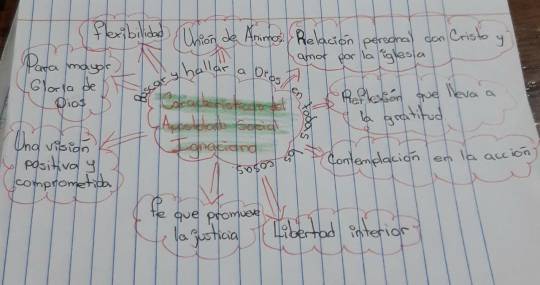
2.Linea de tiempo
De las escuelas u obras de la compañia de Jesus en Centroamerica
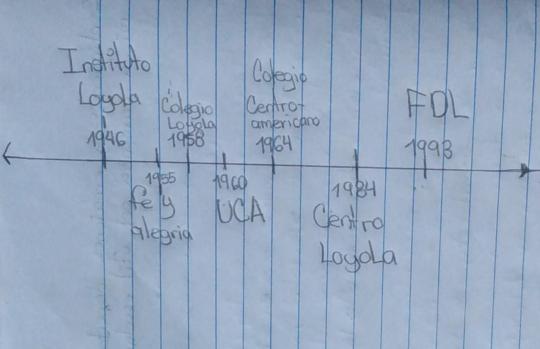
3.Redacta una valoracion personal de los distintos modos de prodecer del apostolado.
Hoy en dia e mejorado mi relacion con Dios al introducir los distitos modos de prodecer del apostolado en vida e mi manera de pensar como cristiano .
4.Sentimientos y emociones despertaron en mi ,la campaña del util escolar.
Me desperto un sentimiento de felicidad y compasion, al entregar un util que le servira a un niño para su estudio.
Mia Nashely Lara Hernandez
7mo A
2 notes
·
View notes
Text
Ghost Of You
I can feel your presence like you were never gone
I can see you in my dreams like a ghost haunting me
I can see your face like a photograph in my memory I cannot erase
I can hear your voice like a song inside my head
I can see you smiling so bright, just like the sun that blinds me
I can still remember that one tragic night like it's all just a dream
0 notes
Text
The Post-Modern Generation
I find it interesting that post-modern ideas have traces of ideas from the Frankfurt school. Today especially my generation have been clamoring for socialist state and I have even seen so many memes about having a Communist state. My generation is struggling with the inequality that we face everyday and they would point out that there is something wrong with the government and that the capitalist state that we have is to be blamed. Given this I do not think that we are Marxists, but I think that most of us are Post Moderns because we value language and communication a lot, that is why we created social media, we could connect with people anytime with our mobile devices. This new form of communication contributes to our narrative. If you check someone else’s social media accounts you will see who they are, their interests, etc. These things make communication easier, sort of makes ice breakers a little bit more easier if you will. With the rise of media, the truth can be easily distorted. People found out different ways to tell the truth, for example the spread of fake news, there would be facts there but it would be presented to mislead people to forward their agenda. So now I see that the center of power shifts to language and communication because people do not use swords and guns to sway political opinion, but now people talk and debate about certain issues important to them.
0 notes
Photo

Abstraction through modelling
0 notes
Photo

“The force is strong in my family”
Light-saber knoll uses straight lines to emphasize the concept of order and respect and size because well...”Judge me by my size, do you?”
0 notes
Text
TYPOGRAPHY - Week 1 - Activity4 - Poster Design
This task was to choose a favourite graphic designer known for their typography work and design an inspired poster in their style. I chose Wolfgang Weingart as my inspiration and found the relevant information about him to put on the poster. Important information such as his date of birth name and and work, and extra information about his styles and achievements throughout the years. The poster needed to be in one colour, so i used different shades of orange.
This was a good kickstarter exercise for me to understand how to put together a poster focussing primarily on shape and type, not the colour or imagery.

0 notes
Photo
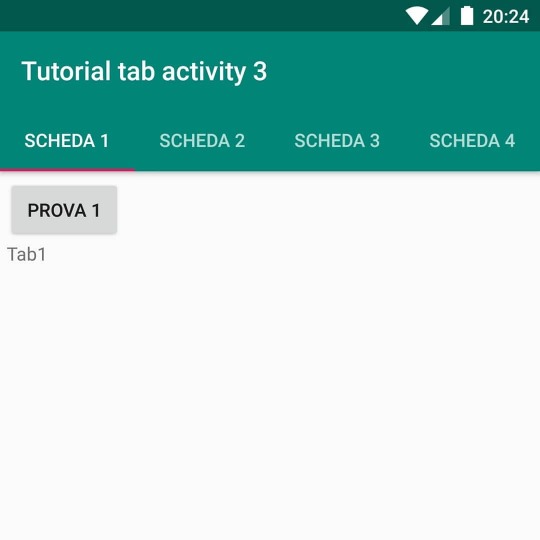
Sul mio Blog nuovo articolo su Android Studio - Tabbed Activity: costruire l'app all'interno delle schede. Link https://davidetech.blogspot.com/2020/05/android-studio-tabbed-activity4.html On my Blog new article on Android Studio - Tabbed Activity: building the app inside the tabs. Link https://davidetech.blogspot.com/2020/05/android-studio-tabbed-activity4.html #programming #appdeveloper #developer #computerscience #programminglife #programminglanguage #google #android #androidstudio #app #kotlin #tabactivity #schede #tab https://www.instagram.com/p/B_u1QQeA3rk/?igshid=iwrkynidx9xj
#programming#appdeveloper#developer#computerscience#programminglife#programminglanguage#google#android#androidstudio#app#kotlin#tabactivity#schede#tab
0 notes
Text
WEEK 4 contemporary activity4
Hollow Knight
Hollow Knight has attracted attention since the crowdfunding stage. Some people say that it uses the game form of "Devil City" and calls it "Bug City". The higher difficulty and black fairy style are also compared by some people as "2D Black soul‘

The reason why it is called "2D Black Soul" is largely because of the death mechanism of this game. After death, all the gold coins carried by the player will be completely lost. The game itself is a dungeon-type game, and the game itself has a high level of exploration. But if the player, especially the novice player wants to explore, you need to buy a lot of equipment in the in-game store, and the source of the game's gold coins is entirely from the battle with the monster, so it is easy for the player in the early stage of the game because It is a very frustrating thing to die in battle and lose all the coins of the accumulated purchase equipment.
Fortunately, after passing the game, when the player has purchased enough equipment, he can explore the depths of the map, then you can understand the true charm of the game - that is, the world view of the game and the design of the characters. "Hollow Knight" chose "insects" as the main world. There are cockroaches, bees, unicorns, and purely fantasy flying insects, fungi, big sword beetles, etc. in the game, including hundreds of different forms. Insect design.
The character design in the game is even more impressive. For example, the profiteers in the game look like locusts, and the locusts are indeed representatives of greed in insects. However, this profiteer is not simply a fortune-seeking person. When a player acquires the "dream nail" skill and can read other people's inner thoughts, he will know that he is always worried about the safety of the protagonist. Many other bugs, some of them look very good at first and will not actively attack the protagonist, but in the later stages of the game, the body of the bug can be found in a similar slaughterhouse. This is reminiscent. Is this a description? Good insects eventually become food for other insects?

0 notes
Text
Representation or Exploitation?
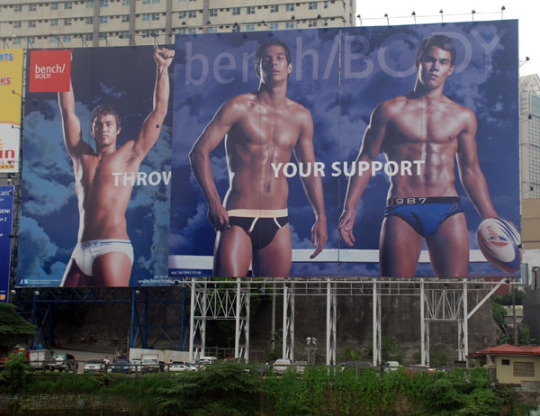
The listed articles all covered a series of sectoral representations in various print media. Reuben Cañente’s article entitled “Bench Underwear Ads and the Male Body,” covered the hypersexualization of men and the blatant visual erogenization of the Male body in Bench Underwear billboards and advertising. According to Cañente (2005), “Its display as a sexual cipher (in aid of commodity capitalism) does not fail to negate its ambiguity as for whom it is ultimately for: patriarchy or heterotopy; emergent homosexuality or hegemonic heterosexism.” In addition. while the emergence of such forms of advertising is a step towards the well-needed sexual liberation of society (especially that of the highly conservative Philippine society), the measures taken comes at varying expenses. Such expenses include that of its ties to capitalist production as well as hypermasculinity which also reinforces the culture of machismo in the country.
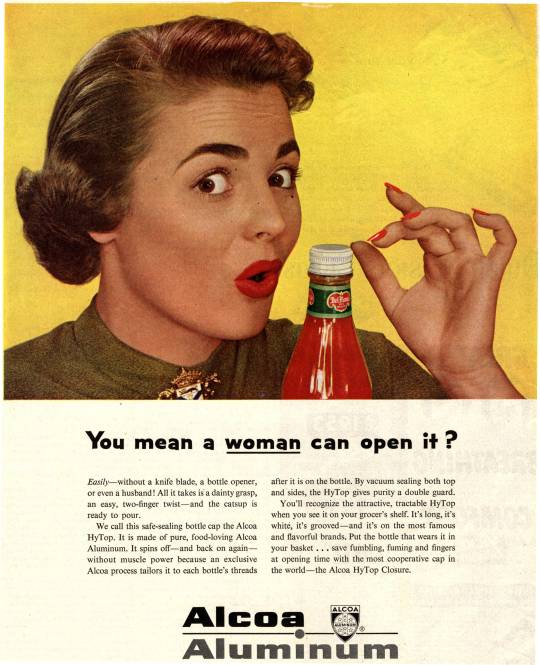
Meanwhile, Georgina Encanto’s article, “Women’s Magazines in English from 1920 to 1972: Instruments of American Hegemony” covers the use of Women’s Magazines to fortification American Hegemony and the subjugation of women under American colonial rule. Encanto (2004), elaborated on “how popular culture, which includes women’s magazines, colluded with the other ideological apparatuses (such as the family, the Church and the educational system) to mold the outlook and way of life of generations of Filipino women,” and emphasized on the detrimental effects of the aforementioned which includes the subtle cultural and ideological subjugation of Filipino Women, enabled by the lack of criticism and continued support, in the form of media consumption, for the ruling colonial capitalist.
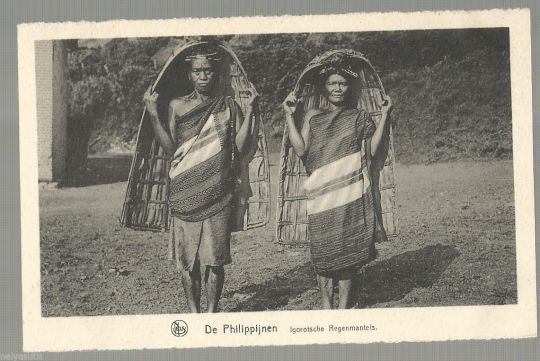
Lastly, Anna Christie Torres’ article, “Igorot representation in Cordillera Picture Postcards,” unboxes the socio-political implications of picture postcards and how it bore the colonial design of conquest in their imagery. Torres whilst referring to Igorot Representation in Picture Postards, added: “In the context of Philippine history, therefore, they document colonial and capitalist encounters that framed and continue to frame the subject within the boundaries of primitive and exotic display.” She expounds on how the thematic representation of the Ifugao impeded their development and further naturalized their “primitivism” through the use of colonial narratives. She adds up on how postcards continuously exploit cultural representation at the expense of reinforcing colonial narratives of indigenous communities.
All of the aforementioned articles tackled the socio-political impact of media representation for varying sectors. For men’s underwear advertisement, there is the employed erogenization of the male bodies as well as the enforcement of hypermasculinity. For women’s magazines, it serves as a tool for desensitizing and exposing women to colonial ideas which eventually led to the colonial subjugation of Filipino women. For Cordillera Picture Postcards, there is the exploitation of the Indigenous community of the Igorot which has boxed them within a primitive and exotic identity shaped by colonial narratives. Such issues are the manifestations of capitalist exploitation of sectoral representation. While there is no stopping capitalist giants from exploiting representation for profit, it is imperative that we educate consumers on media content. Croteau and Hoynes (2003), emphasized this and stated,”we must fully asses the potential impact of media content, we must look at meanings actual audiences attach to the media they read, watch, and listen to,” which sums up on how we should address the matters at hand.
References:
Cañete, R. (2005). Bench Underwear Ads and the Male Body. Plaridel 2, no. 2, 69-92.
Croteau, D. & Hoynes, W. (2003). Media society : industries, images, and audiences (3rd ed). Pine Forge Press, Thousand Oaks, Calif
Tiongson, N., & Umali, V. (2004). Women’s Magazines in English from 1920 to 1972: Instruments of American Hegemony. Plaridel, 1(1), 1–30.
Torres, Anna Christie V. (2006). Igorot Representation in Cordillera Postcards. Plaridel 3, no. 1, 123-146
0 notes
Text
Enhanced Photocatalytic Degradation Properties of Zinc Oxide Nanoparticles Synthesized by using Turnera subulata Sm.
INTRODUCTION Nanotechnology (10-9) is a significant branch in the major fields of biology, chemistry, physics and material sciences. Nanoparticles possess a wide array of application in the different fields’ viz., medicine, electronics, and therapeutics and as diagnostic agents. The nanomaterials can be synthesized by different methods including chemical, physical, irradiation and biological methods. The development of new chemical or physical methods has resulted in environmental contaminations, since the chemical procedures involved in the synthesis of nanomaterials generate a large amount of hazardous byproducts1. Thus, there is a need of “green synthesis” that includes a clean, safe, eco-friendly and environmentally nontoxic method of nanoparticle synthesis. Moreover, in this method there is no need to use high pressure, energy, temperature and toxic chemicals2,3. The metal and metal oxide NPs have attractable properties like biological, electronic, magnetic, and photocatalytic activity4. Zinc oxide nanomaterials are used in the preparation of substances processing medicinally as well as cosmetically useful properties. Due to its antibacterial properties, zinc oxide is applied on the skin, in the form of powders, antiseptic creams, surgical tapes and shampoos, to relieve skin irritation, diaper rash, dry skin and blisters. Zinc oxide is used along with iron oxide to prepare calamine lotion and with eugenol to prepare zinc oxide eugenol which is used for dental applications5,6. Plant extracts mediated synthesis of ZnO nanoparticles has been carried out recently in many plant species like Camellia sinensis7, Ficus benghalensis8, Punica granatum9, Trifolium pretense10, Hibiscus subdariffa11, Aloe vera12, Citrus aurantifolia13, Parthenium hysterophorus14 have been reported in Zinc oxide nanoparticles synthesis by different workers13, 14, 15. Synthetic Dyes can give color to water bodies even when they exist in small amount. They are widely used in various industries such as textile, plastic, paper and rubber industries16. Among these industries, textile industry ranks first in the usage of dyes for coloration of fiber. The textile wastewater is well known to contain strong color, large amount of suspended solids, high fluctuation in pH, high temperature, high COD concentration and other organic contents17. Due to the usage of dye and pigments during the dyeing process, the strong color and turbidity of the textile wastewater effluents caused many problems because of its negative visual impact18. Some of the dyes are toxic and carcinogenic in nature. Methylene Blue (MB), Methyl Violet (MV), Methyl Red (MR), Eosin (E) and Safranin (S) is a basic dye which is used extensively in the dyeing and printing of cotton, silk etc. The high concentration of this dye in contact with the eye can cause corneal injury in human beings. Doses in the range 500 mg can lead to anemia, dizziness, headache, abdominal pain, nausea, profuse sweating and mental confusion19. In the present study, we have synthesized Zinc oxide nanoparticles via green routes using T. subulata leaf extract, giving a special emphasize on growth of nanoparticles at different temperatures. Photocatalytic properties of the synthesized nanoparticles were measured using visible spectroscopy. The synthesized NPs were characterized by spectrometry, FTIR and SEM was used to investigate the particle size. MATERIALS AND METHOD Collection of Plant Materials The flowering plants of Turnera subulata Sm. was collected from the Bishop Heber College campus, Tiruchirappalli. The Plant was identified using the Flora of the Tamilnadu Carnatic20 and authenticated by the Department of Botany, Bishop Heber College, Tiruchirappalli, India. Preparation of the Leaf Extract Ten grams of fresh T. subulata leaves was ground using mortar and pestle added to 100 ml of distilled water and stirred at slow heat. The extract was filtered through muslin cloth and then extract was filtered through Whatmann No.1 filter paper, stored at room temperature in order to be used for further studies. Synthesis of Zinc Oxide Zinc Oxide was prepared using the precipitation method21. Zinc sulfate heptahydrate (ZnSO4.7H2O) and Sodium hydroxide (NaOH) were the two starting materials for the synthesis of ZnO nanoparticles. 0.025 M Zinc sulfate heptahydrate and 0.05M Sodium hydroxide in aqueous solutions. 50 ml of the alkali solution (NaOH) with an approximate rate of 5ml/min was slowly dropped into the Zinc Sulfate Solution22. The solution is stirred under heat vigorously the temperature of 60oC. The precipitates derived from the reaction between the Zinc sulfate and Sodium hydroxide solution were collected by filtering and were rinsed three times with distilled water by centrifugation devices. Then, the final precipitates were collected for the synthesis of ZnO. Characterization of ZnO NP UV-visible spectra were recorded using a spectrophotometer Cary E 500 in a range from 280–800 nm for the confirmation of NP formation. The characterization involved Fourier transform infrared spectroscopy (FTIR) analysis of the dried powder of the synthesized ZnO NPs by Perkin Elmer Spectrum 1000 spectrum in attenuated total reflection mode, and using the spectral range of 4000–400 cm-1 with the resolution of 4 cm-1. The size and morphology of the ZnO NPs were examined by scanning electron microscopy (SU3500, Hitachi). Photocatalytic Degradation of Dye The photocatalytic activity of biosynthesized ZnO NPs was studied by degradation of Methylene Blue (MB), Methyl Violet (MV), Methyl Red (MR), Eosin (E) and Safranin (S) under solar irradiation. The dye solution was prepared by dissolving 1mg powder of Synthetic dyes in 100 ml distilled water. 10 ml ZnO NPs with leaf extract was added to 5 ml of prepared synthetic dye solutions and the mixer was stirred magnetically for 30 min in shadow before exposing to sunlight. The colloidal suspension was then put under solar irradiation with constant stirring. The average temperature of the atmosphere during the experiment found to be 30 °C with 2 hrs mean shine duration. At every 30 min, 5 ml of suspension was collected from the colloidal mixer. The collected suspension was then look over at wavelength from 520 nm using the Systronics type-104 Vis spectrophotometer, to study the dye degradation in presence of ZnO NPs. RESULTS AND DISCUSSION UV-Visible Analysis The UV–visible spectroscopy is a commonly used techniques for optical properties of ZnO nanoparticles23 (Pal et al., 2007) were characterized. The UV–Vis absorption curve of ZnO NPs is shown in Fig. 1. Zinc oxide formation was confirmed as the absorption peak (lambda max) was found near 350 nm. The results showed that the prepared ZnO NPs with T. subulata exhibit an highest absorbance peak (0.500653318 AU) at minimum range 358nm and lowest absorbance peak (0.112728986 AU) at maximum range 1046.7nm (Table 1), which correlates with the already reported results, in which absorption peak was found near most at 360 nm24. FTIR Analysis FTIR analysis was performed to determine the functional groups responsible for the synthesis of ZnO NPs in T. subulata leaf extract. The FTIR spectrum of T. subulata leaf extract is shown in Fig. 2, which shows absorption bands at 675.9 cm-1 (due to overlap of C-H and Zn-O stretching), 1124 cm-1 (C-O Stretch in alkoxy aromatic), 1203 cm-1 (C-O Stretch in ester-acyl, strong), 1273 cm-1 (C-O Stretch in acid-acyl, strong), 1346 cm-1 (O=N-O-R nitro symmetric), 1385 cm-1 (Aromatic amine), 1638 cm-1 (due to overlap of C=C and C=O stretching), 2076 cm-1 (C≡C stretch) and 3437 cm-1 (OH stretch) (Figure 2). The peak at 675.9 cm-1 corresponds to ZnO bonding which confirms the presence of NPs were coated with the polymers.
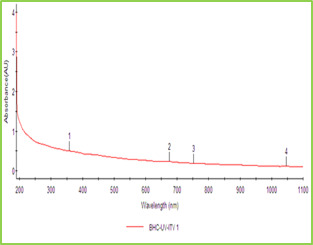
Figure 1: UV-Visible Absorption Spectra of ZnO NPs Synthesized using T. Subulata.
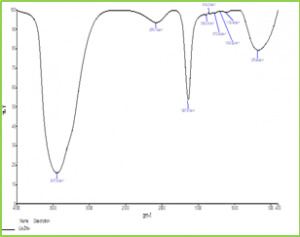
Figure 2: FTIR Graph of ZnO NPs Synthesized from T. subulata Scanning Electron Microscopy (SEM) The Scanning Electron Microscopy (SEM) photographs of ZnO nanoparticles at different magnifications was shown in fig 3. SEM image has shown individual ZnO nanoparticles as well as a number of aggregates. SEM image showed that spherical-shaped nanoparticles and most of the particles exhibit some faceting. SEM results which coincides with results already reported, which shows formation of spherical shaped NPs and aggregated molecules in Calotropis leaf extract25, 26.
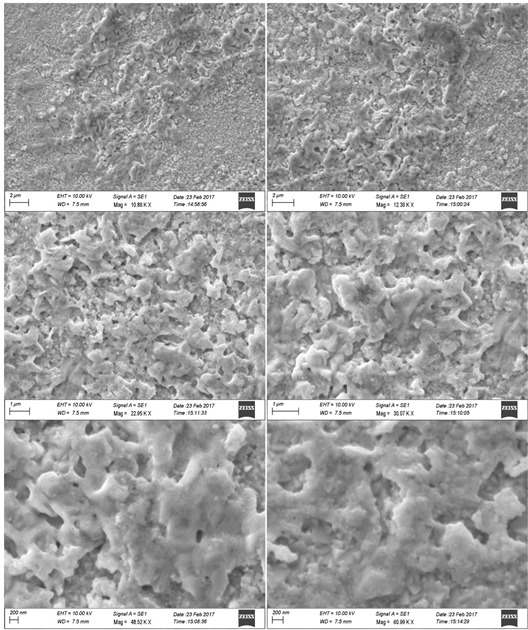
Figure 3: SEM photographs of ZnO NPs in different magnification Photocatalytic Degradation of Dye Photocatalytic activities of biosynthesized ZnO NPs with leaf extract of T. subulata was evaluated using synthetic dyes such as Methylene Blue (MB), Methyl Violet (MV), Methyl Red (MR), Eosin (E) and Safranin (S) in aqueous solutions (1mg/ 100mL). The Photocatalytic activities were revealed the reduction occurs in synthetic dyes using ZnO NPs under sunlight, which results to perform the dye degradation occurs only in Eosin (E) observed 520nm shown in graph (Fig. 4.1.). The present study was compared with ZnO NPs after sunlight with ZnO treated with Leaf extract after sunlight were revealed that the reduction occurred in synthetic dyes using ZnO NPs under sunlight within 2 hrs (immediate response), which results to perform the dye degradation occurs in Methyl Red (MR), Methyl Violet (MV) and Safranin (S) observed 520 nm shown in graph (Fig. 4.2.). Table 1: Photocatalytic Activities of ZnO NPs with Leaf Extract of T. Subulata using Synthetic Dyes S. No Synthetic Dyes Wavelength of Dyes (520nm) Wavelength of ZnO with Dye (520nm) Wave Length of ZnO with Plant extract +Dye (520nm) Before Sunlight After Sunlight Before Sunlight After Sunlight 1 Methyl Red (MR) 0.106 0.116 0.274 0.213 0.102 2 Methyl Violet (MV) 0.046 0.226 0.172 0.232 0.108 3 Methylene Blue (MB) 0.006 0.423 0.051 0.293 0.378 4 Ethyl Eosin (E) 0.348 0.512 0.052 0.506 0.106 5 Safranin (S) 0.221 0.512 0.285 0.380 0.266
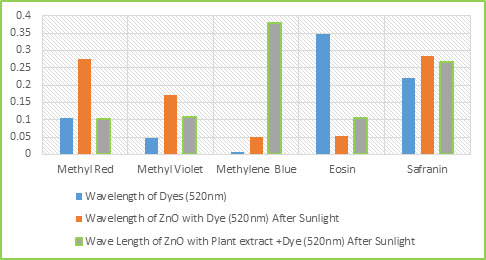
Figure 4.2: Dye Degradation occurs in ZnO NPs synthesized from T. subulata under Sunlight Table 2: Dye Degradation occurs in Different Time Intervals Dyes Time interval Methyl Red Methyl Violet Methylene Blue Ethyl Eosin Safranin 2 0.102 0.108 0.378 0.106 0.266 4 0.096 0.098 0.272 0.099 0.198 6 0.062 0.059 0.109 0.078 0.088
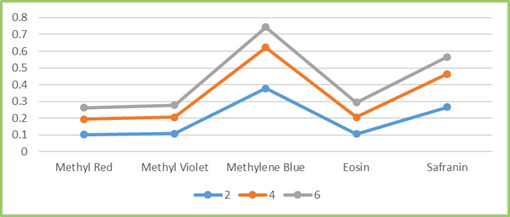
Figure 4.3a.: Dye Degradation Occurs in Different Time Intervals
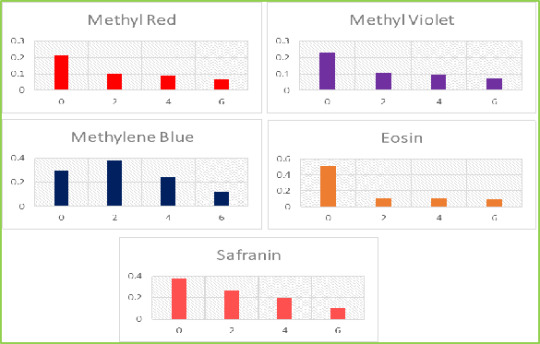
Figure 4.3b.: Dye Degradation Occurs Individuals Different Time Intervals The present study, ZnO NPs after sunlight and ZnO with Leaf extract after sunlight was revealed that the degradation occurs in synthetic dyes under sunlight within 2 hrs, 4 hrs and 6 hrs differences, which results to perform the dye degradation occurs in all synthetic dyes disappears observed 520 nm shown in graph (Fig. 4.3. a and b). The photocatalytic degradation efficiency was calculated as in equation. Dye degradation (%) = { /Co} × 100 % Where Co was the concentration of dye after 30 min of dark run and Ct was the concentration of dye at reaction time, t (min). Table 5: Photocatalytic Degradation Efficiency Dye Dye degradation (%) Methyl Red (MR) 70.8 Methyl Violet (MV) 74.5 Methylene Blue (MB) 62.7 Ethyl Eosin (E) 84.5 Safranin (S) 76.8
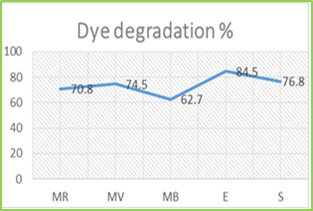
Figure 4.4: Photocatalytic Degradation Efficiency The results obtained in the present study showed that the efficiency of reduction processes to enhance the removing dyes, which resists other conventional treatment processes. Dye degradation appears to be a promising technology that has many applications in environmental cleanup systems. A detailed feasibility study has been carried out on photocatalytic degradation of Methyl Red (MR), Methyl Violet (MV), Ethyl Eosin (E) and Safranin (S) using ZnO NPs & ZnO with Leaf extract as a photo catalyst under sunlight. The Results of the study indicated that ZnO NPs with leaf extract is very effective & suitable alternative to ZnO NPs. The best reaction dosage of ZnO catalyst is about 1mg / 100mL. The maximum degradation efficiency of dye was achieved with the combination of Sunlight (UV) + Leaf extract of T. subulata + ZnO NPs. CONCLUSION Nanomaterials in different forms can be used for removal of other environmental pollutants. Nanoparticles (nano-scale particles = NSPs) obtained from plants, fungi and bacteria, have had actual application in removing some heavy metals from polluted sites. Nanoparticles from plants, fungi and bacteria are useful for detoxification and bioremediation of soil, water and other environments in highly polluted conditions. In future, modification and adaptation of nanotechnology will extend the quality and length of bioremediation. The results obtained from this work showed that ZnO with Leaf extract possessed impressive decolorization efficiency. It can be concluded that, various techniques have been suggested for remediation of waste water. Some of these are too expensive hence not viable. Those that are comparatively inexpensive are not very effective. The best option appears to be one involving several steps like biosorption using locally available agricultural waste followed by biological treatment using ZnO NPs with leaf extract of T. subulata which is very effective and suitable for use in the treatment of solution containing dye. REFERENCES Zhang, M., Liu, M., Prest, H., & Fischer, S. (2008). Nanoparticles secreted from ivy rootlets for surface climbing. Nano letters, 8(5), 1277-1280. https://doi.org/10.1021/nl0725704 , PMid:18355053 Raffi, M., Hussain, F., Bhatti, T. M., Akhter, J. I., Hameed, A., & Hasan, M. M. (2008). Antibacterial characterization of silver nanoparticles against E. coli ATCC-15224. Journal of materials science and technology, 24(2), 192-196. Savithramma, N., Rao, M. L., Rukmini, K., & Devi, P. S. (2011). Antimicrobial activity of silver nanoparticles synthesized by using medicinal plants. International Journal of ChemTech Research, 3(3), 1394-1402. Gnanaprakasam, A., Sivakumar, V. M., Sivayogavalli, P. L., & Thirumarimurugan, M. (2015). Characterization of TiO2 and ZnO nanoparticles and their applications in photocatalytic degradation of azodyes. Ecotoxicology and environmental safety, 121, 121-125. https://doi.org/10.1016/j.ecoenv.2015.04.043 , PMid:25937630 Ferracane, J. L. 2001 Materials in Density: Principles and Applications. Lippincott Williams & Willkins, Philadelphia Richard Van Noort. 2002. Introduction to Dental Materials. 2nd Edition. Elsevier Health Science, Ediburgh. Shah, R. K., Boruah, F., & Parween, N. (2015). Synthesis and characterization of ZnO nanoparticles using leaf extract of Camellia sinesis and evaluation of their antimicrobial efficacy. Int. J. Curr. Microbiol. App. Sci, 4(8), 444-450. Shekhawat, M. S., Ravindran, C. P., & Manokari, M. (2015). A Green Approach to Synthesize the Zinc Oxide Nanoparticles using Aqueous Extracts of Ficus benghalensis L. International Journal of BioSciences, Agriculture and Technology, 6(1), 1-5. Mishra, V., & Sharma, R. (2015). Green synthesis of zinc oxide nanoparticles using fresh peels extract of Punica granatum and its antimicrobial activities. International Journal of Pharma Research and Health Sciences, 3(3), 694-699. Dobrucka, R., & Długaszewska, J. (2016). Biosynthesis and antibacterial activity of ZnO nanoparticles using Trifolium pratense flower extract. Saudi journal of biological sciences, 23(4), 517-523. https://doi.org/10.1016/j.sjbs.2015.05.016 , PMid:27298586 , PMCid:PMC4890195 Bala, N., Saha, S., Chakraborty, M., Maiti, M., Das, S., Basu, R., & Nandy, P. (2015). Green synthesis of zinc oxide nanoparticles using Hibiscus subdariffa leaf extract: effect of temperature on synthesis, anti-bacterial activity and anti-diabetic activity. RSC Advances, 5(7), 4993-5003. https://doi.org/10.1039/C4RA12784F Varghese, E., & George, M. (2015). Green synthesis of zinc oxide nanoparticles. Int. J. Adv. Res. Sci. Eng, 4(1), 307-314. Samat, N. A., & Nor, R. M. (2013). Sol–gel synthesis of zinc oxide nanoparticles using Citrus aurantifolia extracts. Ceramics International, 39, S545-S548. https://doi.org/10.1016/j.ceramint.2012.10.132 Rajiv, P., Rajeshwari, S., & Venckatesh, R. (2013). Bio-Fabrication of zinc oxide nanoparticles using leaf extract of Parthenium hysterophorus L. and its size-dependent antifungal activity against plant fungal pathogens. Spectrochimica Acta Part A: Molecular and Biomolecular Spectroscopy, 112, 384-387. https://doi.org/10.1016/j.saa.2013.04.072 , PMid:23686093 Gunalan, S., Sivaraj, R., & Rajendran, V. (2012). Green synthesized ZnO nanoparticles against bacterial and fungal pathogens. Progress in Natural Science: Materials International, 22(6), 693-700. https://doi.org/10.1016/j.pnsc.2012.11.015 Kanawade, S. M., & Gaikwad, R. W. (2011). Removal of methylene blue from effluent by usingactivated carbon and water hyacinth as adsorbent. International Journal of Chemical Engineering and Applications, 2(5), 317-319. https://doi.org/10.7763/IJCEA.2011.V2.126 Lin, S. H., & Lai, C. L. (2000). Kinetic characteristics of textile wastewater ozonation in fluidized and fixed activated carbon beds. Water Research, 34(3), 763-772. https://doi.org/10.1016/S0043-1354(99)00214-6 Sengil, I. A., Özacar, M., & ÖMüRLü, B. (2004). Decolorization of CI reactive red 124 using the electrocoagulation method. Chemical and biochemical engineering quarterly, 18(4), 391-401. Ponnusami, V., Vikram, S., & Srivastava, S. N. (2008). Guava (Psidium guajava) leaf powder: novel adsorbent for removal of methylene blue from aqueous solutions. Journal of hazardous materials, 152(1), 276-286. https://doi.org/10.1016/j.jhazmat.2007.06.107, PMid:17692457 Matthew, K. M. (1983). The flora of the Tamilnadu Carnatic(Vol. 3). Daneshvar, N., Aber, S., Dorraji, M. S., Khataee, A. R., & Rasoulifard, M. H. (2007). Preparation and investigation of photocatalytic properties of ZnO nanocrystals: effect of operational parameters and kinetic study, International Journal of Chemical, Molecular, Nuclear, Materials and Metallurgical Engineering. 1(5), 23–28. Zareie, M., Gholami, A., Bahrami, M., Rezaei, A. H., & Keshavarz, M. H. (2013). A simple method for preparation of micro-sized ZnO flakes. Materials Letters, 91, 255-257. https://doi.org/10.1016/j.matlet.2012.10.013 Pal, A., Shah, S., & Devi, S. (2007). Preparation of silver, gold and silver–gold bimetallic nanoparticles in w/o microemulsion containing TritonX-100. Colloids and Surfaces A: Physicochemical and Engineering Aspects, 302(1-3), 483-487. https://doi.org/10.1016/j.colsurfa.2007.03.032 Jayarambabu, N., Kumari, B. S., Rao, K. V., & Prabhu, Y. T. (2014). Germination and growth characteristics of mungbean seeds (Vigna radiata L.) affected by synthesized zinc oxide nanoparticles. International Journal of Current Engineering and Technology, 4(5), 2347-5161. Vidya, C., Hiremath, S., Chandraprabha, M. N., Antonyraj, M. L., Gopal, I. V., Jain, A., & Bansal, K. (2013). Green synthesis of ZnO nanoparticles by Calotropis gigantea. Int J Curr Eng Technol, 1, 118-120. Chaudhuri, S. K., & Malodia, L. (2017). Biosynthesis of zinc oxide nanoparticles using leaf extract of Calotropis gigantea: characterization and its evaluation on tree seedling growth in nursery stage. Applied Nanoscience, 7(8), 501-512. Read the full article
0 notes
Photo

Abstraction through modelling
0 notes
Photo


This is my advertisement for my magazine called ‘The Wandering Eye’. I used Bridge to edit my photos, Photoshop to compose the image and Indesign to create the composition for the ad.
#Activity4
0 notes